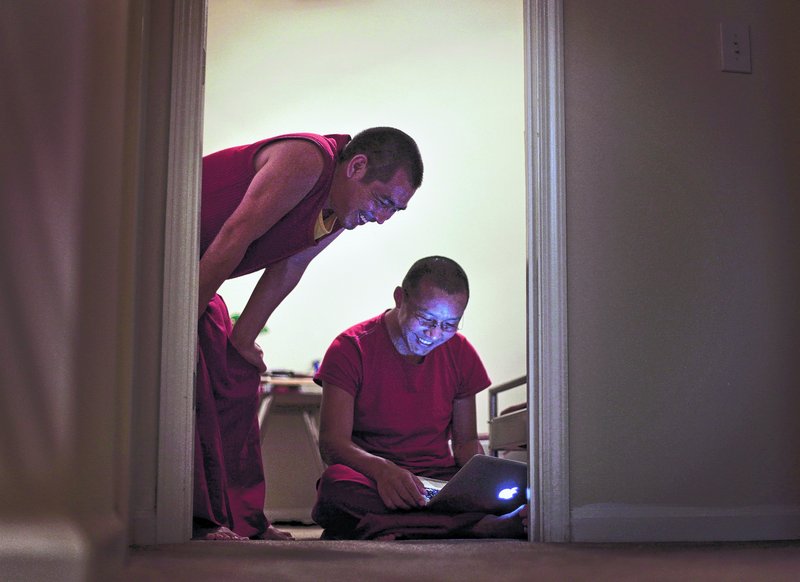ATLANTA – Munching on pizza. Posting on Facebook. Hanging out with friends on weekends.
Some of the newest students at Emory University may act like typical college kids, but there’s a key difference: They’re Tibetan monks sent by the Dalai Lama to the United States to learn science.
Wearing the traditional crimson robes and closely shorn heads of Tibetan monastics, the six men — most in their 30s — are taking physics, biology and chemistry classes with hopes of returning to Tibetan monasteries in India to teach science to other monks and nuns.
It’s the first established program for Tibetan monks from India to train at a Western university, said Geshe Lhakdor, director of the Library of Tibetan Works and Archives in India. “They are pioneers,” he said in a recent interview while visiting Atlanta.
The program is the newest evolution of the Emory-Tibet Science Initiative, which is helping the Dalai Lama with his goal of training monastics for the 21st century. Monks and nuns are masters of the mind through the practice of ancient traditions, but they must also master modern concepts of science and technology, the exiled Tibetan spiritual leader said during a recent visit to Emory.
“The monastic institution is traditionally the learning center, so we must put science in this institution,” the Dalai Lama said. “Even Buddha himself said ‘All my followers shouldn’t accept my teachers out of faith, but out of constant investigation.”‘
For the monks, the year spent at Emory means long hours sitting in classes conducted in a language they struggle with and terms they’ve never studied before. Try explaining the concept of photosynthesis — a process where plants turn carbon dioxide into oxygen with the help of sunlight — to someone who has never even heard of a chemical compound.
“My mother wasn’t happy about my coming here,” said Ngawang Norbu, 36, who is from Bylakuppe, the largest Tibetan settlement in India. “But when I told her it was part of His Holiness’s vision, she was very happy. I’m taking a small step toward fulfilling his wishes.”
Each morning the monks wake up early to meditate in their bedrooms before heading to classes, meetings with professors or English tutoring sessions. They cook meals at their off-campus apartment to save money and shop together at Indian food markets and the dollar store.
In their free time, the monks pore over their lessons, revise homework, watch science teachings in English on YouTube and play sports with Emory classmates. Some of the monks listen to the Dalai Lama’s teachings on mp3 players on the way to class or watch videos of the spiritual leader online.
The monks use Facebook as a way to connect with classmates at Emory and keep up with their fellow monks and nuns back home. Some of the monks had to take a crash course in using a computer when they got to campus because they don’t have much access to technology at the monasteries.
“In the monastery, we don’t use the Internet that much,” said monk Kunjo Baiji, 30, adding that the connection is slow and undependable in India.
The Emory-Tibet Partnership hopes to bring a handful of monks and nuns to campus each year to take science classes.
The relationship between Emory and Tibet began in 1991 when former Tibetan monk Geshe Lobsang Negi moved to Atlanta with the blessings of the Dalai Lama to establish the Drepung Loseling Institute, a Buddhist monastery and learning center near campus. Slowly a partnership began to evolve, and in 1998, the university formally launched the Emory-Tibet Partnership.
Three years ago, Emory professors published a general science textbook translated into Tibetan. They travel each year to Dharamsala, India, home of the Dalai Lama’s headquarters, to teach science to monks and nuns.
And dozens of Emory students go to Dharamsala annually to study at the Institute of Buddhist Dialectics, where the Dalai Lama is the founder and a top teacher.
The close ties with Emory led the Dalai Lama to accept a five-year appointment as a distinguished professor at the private university in 2007 — with regular visits to campus to give lectures and work with faculty and students. Although the Dalai Lama has honorary professorships at universities across the globe, Emory was the first place he has a teaching professorship.
The Dalai Lama, winner of the 1989 Nobel Peace Prize, has talked of mixing science and mathematics training into monastic life for years but wasn’t able to do it until Emory developed curriculum in the monks’ native tongue.
There have been challenges: Professors well versed in evolution are looking for ways to explain the theory to monks who believe in reincarnation, and translators have had to develop new Tibetan words to describe some scientific concepts that don’t exist in Eastern traditions.
“I was very happy when I heard I could come here,” said Sherub Tenzin, 33, one of the monks who fled Tibet for India when he was 19. “In India, we cannot learn science like this.”
Send questions/comments to the editors.




Success. Please wait for the page to reload. If the page does not reload within 5 seconds, please refresh the page.
Enter your email and password to access comments.
Hi, to comment on stories you must . This profile is in addition to your subscription and website login.
Already have a commenting profile? .
Invalid username/password.
Please check your email to confirm and complete your registration.
Only subscribers are eligible to post comments. Please subscribe or login first for digital access. Here’s why.
Use the form below to reset your password. When you've submitted your account email, we will send an email with a reset code.